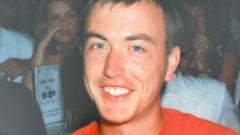Watch: A day of violence and fear
The Palestinian militant group Hamas launched an unprecedented attack on Israel on 7 October, killing more than 1,400 people and taking more than 220 hostages.
Gaza's health ministry says more than 5,000 people have been killed in the territory since Israel launched retaliatory air strikes, and a ground offensive is expected.
What has been happening in the Gaza Strip?
There remains a "dire need of humanitarian aid" in Gaza, the UN has warned.
At least 34 lorries carrying food, water and medical supplies were allowed through the Rafah border crossing from Egypt over the weekend.
However, this provided only a fraction of the needs of people in Gaza, which normally receives 400 to 500 lorries every day.
The UN's agency for Palestinian refugees, Unrwa, said access to clean water was severely limited and that "concerns over dehydration and waterborne diseases are high".
An estimated 1.4 million people in Gaza have been displaced, according to the UN.
Hundreds of thousands moved from the north of the territory to the south, after being told by the Israeli military to leave for their own safety.
The southern city of Khan Younis, normally home to 400,000 people, has seen its population increase to more than a million. Many families are sharing homes, or sleeping in tents.
However, Israel has also continued to carry out strikes on what it says are Hamas military targets in southern Gaza.
Some of those who initially fled the north of Gaza are now returning because the situation in the south is so bad, the UN has said.
The World Health Organization has also warned that it is "almost impossible" for patients in hospitals in northern Gaza to be evacuated.
Will Israel invade Gaza?
Israel's stated goal is to destroy Hamas.
Defence Minister Yoav Gallant said on Sunday that the next stage of the operation in Gaza - an expected ground offensive - "may take a month, two or three, but at the end there will be no more Hamas".
Israel also wants to bring back the hostages that Hamas seized.
Israel has massed tens of thousands of soldiers along the Gaza perimeter fence, along with tanks and artillery. It has activated some 300,000 reservists, alongside its standing force of 160,000.
Hamas is thought to have about 25,000 people in its military wing, the Izzedine al-Qassam Brigades.
The Israeli military is preparing for an offensive by bombarding hundreds of targets inside Gaza.
One of its main targets is Hamas's vast labyrinth of underground tunnels, which contain bunkers for leaders and operational headquarters.
Hamas has previously claimed the tunnels stretch for 500km (310 miles). Many have entrances hidden within houses, mosques, schools and other public buildings.
Israel's troops are likely to avoid going into tunnels unless they have to, instead using explosives to destroy them.
A major challenge for the Israeli troops will be close-quarters fighting in densely populated urban areas. It is thought that Hamas will lay booby traps and improvised explosive devices at entry points such as doorways, and along narrow streets.
On Monday, the Israeli military said one Israeli soldier was killed and several others wounded during a raid into Gaza, to try and find hostages and to clear the way for a ground attack.
The leaders of the US, UK, Canada, France, Germany, and Italy on Sunday "reiterated their support for Israel and its right to defend itself against terrorism" and called for "adherence to international humanitarian law, including the protection of civilians".
What is Hamas and what does it want?
Hamas is a Palestinian militant group which has ruled the Gaza Strip since 2007. The group is sworn to Israel's destruction and wants to replace it with an Islamic state.
Hamas has fought several wars with Israel since it took power. It has fired - or allowed other militant groups to fire - thousands of rockets into Israel, and has carried out other deadly attacks.
In response, Israel has repeatedly attacked Hamas with air strikes. In 2008 and 2014, it also sent troops into Gaza.
Together with Egypt, Israel has blockaded the Gaza Strip since 2007 for what it describes as security reasons.
Hamas - or in some cases its military wing, the Izzedine al-Qassam Brigades - has been designated a terrorist group by Israel, the United States, the European Union and the UK, as well as other powers.
Iran backs the group, providing it with funding, weapons and training.
What was the Hamas attack on Israel?
Image source, Oren Rosenfeld
Image caption,Hamas killed families in their homes in the kibbutz of Kfar Aza
On 7 October, hundreds of Hamas gunmen crossed from the Gaza Strip into southern Israel by breaking through the heavily-fortified perimeter fence, landing by sea, and using paragliders.
The gunmen killed 1,400 people, most of them civilians, in a series of raids on military posts, kibbutzim and a music festival, and took hostages back into Gaza.
Given the resources of Israel's security services, it was astounding that the attack by Hamas was not anticipated, the BBC's security correspondent Frank Gardner says.
It came at a time of soaring Israeli-Palestinian tensions.
This year has been the deadliest on record for Palestinians who live in the Israeli-occupied West Bank, which could have motivated Hamas to strike Israel.
Hamas might also have been seeking to score a significant propaganda victory to boost its popularity among ordinary Palestinians.
The capture of Israeli hostages is thought to be designed to pressure Israel to free some of the estimated 4,500 Palestinians held in Israeli prisons.
The Israeli military currently believes 222 people are being held in Gaza.
They include 20 children and at least 10 people aged over 60. Soldiers were also taken hostage.
More on Israel-Gaza war
What is the Gaza Strip and who lives there?
The Gaza Strip is a 41km (25-mile) long and 10km-wide territory located between Israel, Egypt and the Mediterranean Sea.
Originally occupied by Egypt, Gaza was captured by Israel during the 1967 Six Day war.
Israel withdrew its troops and around 7,000 settlers from the territory in 2005.
It is home to 2.23 million people and has one of the highest population densities in the world.
Just over 75% of Gaza's population - some 1.7 million people - are registered refugees or descendants of refugees, according to the UN. More than 500,000 of them live in eight crowded camps located across the Strip.
Israel controls the air space over Gaza and its shoreline, and has strictly controlled the movement of people and goods.
What is Palestine?
The West Bank and Gaza, which are known as the Palestinian territories, as well as East Jerusalem and Israel all formed part of a land known as Palestine from Roman times until the mid-20th Century.
These were also the lands of Jewish kingdoms in the Bible, and are seen by many Jews as their ancient homeland.
Israel was declared a state in 1948, though the land is still referred to as Palestine by those who do not recognise Israel's right to exist.
Palestinians also use the name Palestine as an umbrella term for the West Bank, Gaza and East Jerusalem.
The Palestinian president is Mahmoud Abbas, also known as Abu Mazen. He is based in the West Bank, which is under Israeli occupation.
He has been the leader of the Palestinian Authority (PA) since 2005, and represents the Fatah political party, a bitter rival of Hamas.

 6 months ago
6 months ago
.png)









